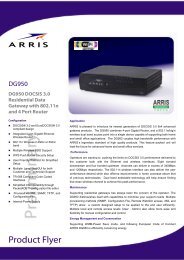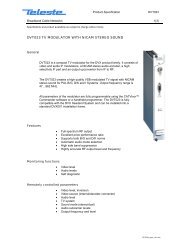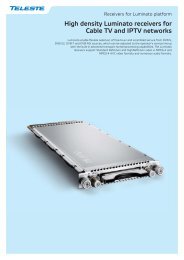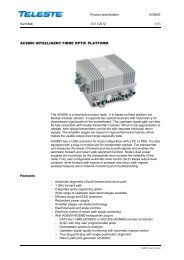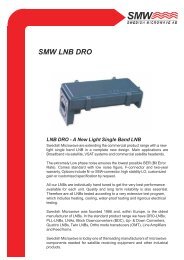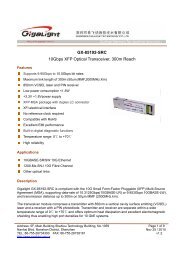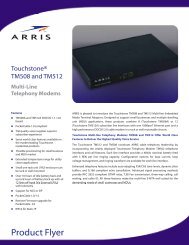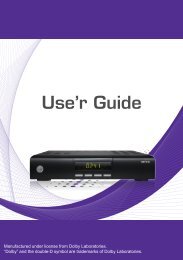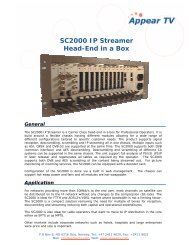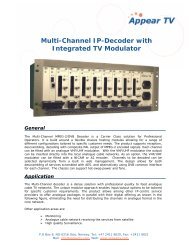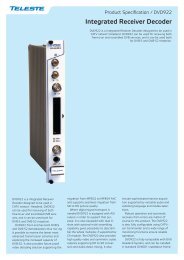Product specification - HFC Technics
Product specification - HFC Technics
Product specification - HFC Technics
Create successful ePaper yourself
Turn your PDF publications into a flip-book with our unique Google optimized e-Paper software.
<strong>Product</strong> <strong>specification</strong> AC6980<br />
5.11.2012 1(3)<br />
AC6980 DOCSIS TRANSPONDER<br />
AC6980 is a DOCSIS transponder module containing DOCSIS modem and a<br />
level measurement unit. It can be used to add remote monitoring and control,<br />
ALSC with fully user programmable pilots, automatic forward and return path<br />
alignment, forward path spectrum analyser and return path ingress analyser to<br />
compatible AC platforms.<br />
Features<br />
General<br />
− Compatible with AC3000, AC3200, AC8700, AC8800 and AC9000 platforms<br />
− Plug-in unit with no additional cables<br />
− Lid status monitoring with light sensor<br />
− Pushbutton for true Plug-and-Play: full automatic alignment of both forward<br />
and return path signal paths<br />
Modem and management<br />
− DOCSIS/EuroDOCSIS 1.1/2.0 transponder<br />
− Remote monitoring and control of all parameters<br />
− Remote update of transponder and platform embedded software<br />
− Standard DOCSIS SNMP MIBs for DOCSIS management<br />
− Amplifier / node management via SCTE HMS / Teleste MIBs<br />
− Supports remote Teleste TSEMP management allowing more sophisticated<br />
management features such as measurement logging with CATVisor tools.<br />
Level measurement and ALSC<br />
− Fast and accurate level measurement unit can measure any forward path<br />
channel level with selectable peak / average detection<br />
− ALSC pilot frequencies are user programmable with automatic reserve pilot<br />
switching; full gain and slope control with two pilots, automatic switching to<br />
gain-only control with only one pilot<br />
− Fast forward path spectrum analyser functionality with user programmable<br />
frequencies, graphical display and automatic limit testing with alarms<br />
Ingress monitoring and control<br />
− Ingress Buster, the return path signal monitoring system with measurement<br />
dynamic range extended down to noise level can detect and report ingress<br />
− Return path can be attenuated or even cut off while still maintaining return<br />
path signal measurement functionality and remote modem connection<br />
− Ingress Buster can be used for automated actions against ingress: return<br />
path can be automatically attenuated by user specified amout, or<br />
preconfigured ingress filter can be automatically activated, or both, with userselectable<br />
thresholds and timeouts<br />
AC6980_spec_v10.doc
<strong>Product</strong> <strong>specification</strong> AC6980<br />
5.11.2012 2(3)<br />
Technical <strong>specification</strong>s<br />
Parameter Specification Note<br />
Notes<br />
Communication<br />
Protocol DOCSIS/EuroDOCSIS 1.1/2.0<br />
Downstream frequency range<br />
108...862 MHz<br />
Upstream frequency range<br />
5...65 MHz<br />
Downstream input level range 68...98 dBµV 1)<br />
Equivalent forward path output level<br />
87...117 dBµV<br />
Upstream output level range 67...117 dBµV 2)<br />
Equivalent full gain return path input levels:<br />
AC3000<br />
40...90 dBµV<br />
AC3200<br />
40...90 dBµV<br />
AC8700<br />
30...80 dBµV<br />
AC8800<br />
35...85 dBµV<br />
AC9000<br />
30...80 dBµV<br />
Forward path RF level measurements: ALSC and spectrum analyser<br />
Forward path measurement range<br />
50…1000 MHz, 0.25 MHz steps<br />
Measurement bandwidth 0.35 MHz 3)<br />
Measurement inaccuracy < 1.0 dB 4)<br />
Dynamic range 80…120 dBµV 5)<br />
Detection mode<br />
Analog / QAM<br />
Return path RF level measurements: Ingress Buster<br />
Return path measurement range<br />
5…85 MHz, 0.25 MHz steps<br />
Measurement bandwidth 0.35 MHz 3)<br />
Measurement inaccuracy < 1.5 dB 6)<br />
Dynamic range 15…75 dBµV 7)<br />
Detection mode<br />
Signal / Noise<br />
General information<br />
Power consumption<br />
3.8 W<br />
Supply voltages<br />
+12 V / 280 mA<br />
+24 V / 20 mA<br />
Dimensions 80 x 52 x 21 mm h x w x d<br />
Weight<br />
0.2 kg<br />
Operating temperature range<br />
see platform <strong>specification</strong>s<br />
EMC EN 50083-2<br />
1) Levels are referenced to transponder RF input, which typically has -19 dB offset to amplifier /<br />
node output port 1, depending on output configuration (see platform specs).<br />
2) Levels are referenced to transponder RF output, which typically has -37...-27 dB offset to return<br />
path input at full gain, depending on platform and gain setting (see platform specs).<br />
3) Typical –3 dB bandwidth. Typical –45 dB bandwidth is 0.5 MHz.<br />
4) This is the typical performance over band 50…740 MHz for analog signals. For analog signals<br />
between 740…1006 MHz and all QAM signals the inaccuracy is < 1.7 dB.<br />
5) For modulated analog signal. For QAM detection the dynamic range is ~6 dB higher. QAM<br />
detection measures a ~1.5 MHz band and the level calculation assumes the carrier to be 6.875<br />
Msymbols/s signal. Signal levels are referenced to forward path output port.<br />
6) Typical performance for QAM / noise measurement.<br />
7) For noise measurement. Return path signal levels are referenced to return path input port.<br />
Dynamic range typically extends down to 10 dBµV, but is not quaranteed due to internal mixing<br />
products in e.g. 7...12 MHz range.<br />
AC6980_spec_v10.doc
<strong>Product</strong> <strong>specification</strong> AC6980<br />
5.11.2012 3(3)<br />
Block diagram<br />
DIGITAL CONNECTOR<br />
FRONT PANEL<br />
LEDS<br />
RF CONNECTOR<br />
US INPUT<br />
DS INPUT<br />
US OUTPUT<br />
LEVEL<br />
MEASUREMENT<br />
UNIT<br />
DOCSIS<br />
MODEM<br />
RX<br />
TX<br />
LIGHT<br />
SENSOR<br />
BUTTON<br />
General operation principles<br />
The DOCSIS modem is based on TI/Intel Puma chipset. It operates as standard<br />
EuroDOCSIS 1.1/2.0 cable modem with standard DOCSIS installation and<br />
provisioning principles including DHCP & ToD servers and TFTP configuration<br />
file download.<br />
The DOCSIS RF MAC address needed for unit identification is visible in<br />
AC6980 front panel in both human readable and matrix barcode format.<br />
The transponder and the connected amplifier/node appear together as a single<br />
IP address towards the CMTS. The DOCSIS part can be managed with<br />
standard DOCSIS SNMP MIBs. The amplifier / node management is via<br />
standard SCTE HMS and Teleste proprietary SNMP MIBs. SNMP communities<br />
and trap receivers are managed using standard DOCSIS methods.<br />
The DOCSIS modem firmware can be updated remotely using standard<br />
DOCSIS practices (TFTP). The amplifier / node software can be updated locally<br />
using Teleste CATVisor Commander software or remotely using standard SCTE<br />
HMS-DOWNLOAD-MIB methods.<br />
SNMP: Supported Teleste and SCTE MIBs<br />
TELESTE-ROOT-MIB<br />
TELESTE-COMMON-MIB<br />
TELESTE-ACX-MIB<br />
TELESTE-ANALYSER-MIB<br />
TELESTE-ALARMS-MIB<br />
SCTE-ROOT-MIB<br />
SCTE-HMS-ROOTS-MIB<br />
SCTE-HMS-PROPERTY-MIB<br />
SCTE-HMS-ALARMS-MIB<br />
SCTE-HMS-COMMON-MIB<br />
SCTE-HMS-FIBERNODE-MIB<br />
SCTE-HMS-DOWNLOAD-MIB<br />
SCTE-HMS-RFAMPLIFIER-MIB<br />
In addition to the above mentioned MIBs standard DOCSIS and some<br />
proprietary MIBs are also supported.<br />
AC6980_spec_v10.doc



